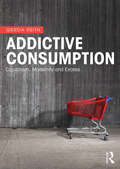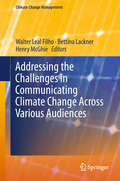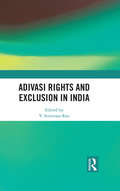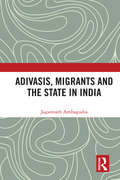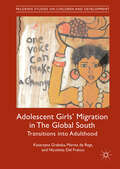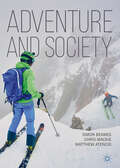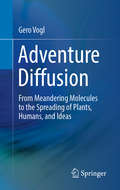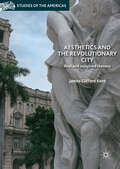- Table View
- List View
Addictive Consumption: Capitalism, Modernity and Excess
by Gerda ReithIn this engaging new book, Gerda Reith explores key theoretical concepts in the sociology of consumption. Drawing on the ideas of Foucault, Marx and Bataille, amongst others, she investigates the ways that understandings of ‘the problems of consumption’ change over time, and asks what these changes can tell us about their wider social and political contexts. Through this, she uses ideas about both consumption and addiction to explore issues around identity and desire, excess and control and reason and disorder. She also assesses how our concept of 'normal' consumption has grown out of efforts to regulate behaviour historically considered as disruptive or deviant, and how in the contemporary world the 'dark side' of consumption has been medicalised in terms of addiction, pathology and irrationality. By drawing on case studies of drugs, food and gambling, the volume demonstrates the ways in which modern practices of consumption are rooted in historical processes and embedded in geopolitical structures of power. It not only asks how modern consumer culture came to be in the form it is today, but also questions what its various manifestations can tell us about wider issues in capitalist modernity. Addictive Consumption offers a compelling new perspective on the origins, development and problems of consumption in modern society. The volume’s interdisciplinary profile will appeal to scholars and students in sociology, psychology, history, philosophy and anthropology.
Addressing the Challenges in Communicating Climate Change Across Various Audiences (Climate Change Management)
by Henry McGhie Bettina Lackner Walter Leal FilhoThis book offers a concrete contribution towards a better understanding of climate change communication. It ultimately helps to catalyse the sort of cross-sectoral action needed to address the phenomenon of climate change and its many consequences. There is a perceived need to foster a better understanding of what climate change is, and to identify approaches, processes, methods and tools which may help to better communicate it. There is also a need for successful examples showing how communication can take place across society and stakeholders. Addressing the challenges in communicating to various audiences and providing a platform for reflections, it showcases lessons learnt from research, field projects and best practices in various settings in various different countries. The acquired knowledge can be adapted and applied to other situations.
Adivasi Rights and Exclusion in India
by V. Srinivasa RaoThis volume examines the processes and impacts of exclusion on the Adivasis (tribal or indigenous people) in India and what repercussions these have for their constitutional rights. The chapters explore a wide range of issues connected to the idea of exclusion — land and forest resources, habitats and livelihoods, health and disease management, gender relations, language and schooling, water resources, poverty, governance, markets and technology, and development challenges — through case studies from different parts of the country. The book argues that any laws intended to safeguard the fundamental rights of Adivasis must acknowledge the fact that their diverse and complex identities are not homogenous, and that uniform laws have failed to address their systemic marginalisation since the colonial era. This work appeals for a serious and meaningful political intervention towards tribal development. The volume will be useful to scholars and researchers of tribal and Third World studies, sociology and social anthropology, exclusion studies and development studies.
Adivasi Rights and Exclusion in India
by V. Srinivasa RaoThis volume examines the processes and impacts of exclusion on the Adivasis (tribal or indigenous people) in India and what repercussions these have for their constitutional rights. The chapters explore a wide range of issues connected to the idea of exclusion — land and forest resources, habitats and livelihoods, health and disease management, gender relations, language and schooling, water resources, poverty, governance, markets and technology, and development challenges — through case studies from different parts of the country. The book argues that any laws intended to safeguard the fundamental rights of Adivasis must acknowledge the fact that their diverse and complex identities are not homogenous, and that uniform laws have failed to address their systemic marginalisation since the colonial era. This work appeals for a serious and meaningful political intervention towards tribal development. The volume will be useful to scholars and researchers of tribal and Third World studies, sociology and social anthropology, exclusion studies and development studies.
Adivasis, Migrants and the State in India
by Jagannath AmbagudiaThis book looks at the contested relationship between Adivasis or the indigenous peoples, migrants and the state in India. It delves into the nature and dynamics of competition and resource conflicts between the Adivasis and the migrants. Drawing on the ground experiences of the Dandakaranya Project – when Bengali migrants from erstwhile East Pakistan (now Bangladesh) were rehabilitated in eastern and central India – the author traces the connection between resource scarcity and the emergence of Naxalite politics in the region in tandem with the key role played by the state. He critically examines the way in which conflicts between these groups emerged and interacted, were shaped and realised through acts and agencies of various kinds, as well as their socio-economic, cultural and political implications. The book explores the contexts and reasons that have led to the dispossession, deprivation and marginalisation of Adivasis. Through rich empirical data, this book presents an in-depth analysis of a contemporary crisis. It will be useful to scholars and researchers of political studies, South Asian politics, conflict studies, political sociology, cultural studies, sociology and social anthropology.
Adivasis, Migrants and the State in India
by Jagannath AmbagudiaThis book looks at the contested relationship between Adivasis or the indigenous peoples, migrants and the state in India. It delves into the nature and dynamics of competition and resource conflicts between the Adivasis and the migrants. Drawing on the ground experiences of the Dandakaranya Project – when Bengali migrants from erstwhile East Pakistan (now Bangladesh) were rehabilitated in eastern and central India – the author traces the connection between resource scarcity and the emergence of Naxalite politics in the region in tandem with the key role played by the state. He critically examines the way in which conflicts between these groups emerged and interacted, were shaped and realised through acts and agencies of various kinds, as well as their socio-economic, cultural and political implications. The book explores the contexts and reasons that have led to the dispossession, deprivation and marginalisation of Adivasis. Through rich empirical data, this book presents an in-depth analysis of a contemporary crisis. It will be useful to scholars and researchers of political studies, South Asian politics, conflict studies, political sociology, cultural studies, sociology and social anthropology.
Adolescent Girls' Migration in The Global South: Transitions into Adulthood (Palgrave Studies on Children and Development)
by Katarzyna Grabska Marina de Regt Nicoletta Del FrancoThis book provides a nuanced, complex, comparative analysis of adolescent girls’ migration and mobility in the Global South. The stories and the narratives of migrant girls collected in Bangladesh, Ethiopia and Sudan guide the readers in drawing the contours of their lives on the move, a complex, fluid scenario of choices, constraints, setbacks, risks, aspirations and experiences in which internal or international migration plays a pivotal role. The main argument of the book is that migration of adolescent girls intersects with other important transitions in their lives, such as those related to education, work, marriage and childbearing, and that this affects their transition into adulthood in various ways. While migration is sometimes negative, it can also offer girls new and better opportunities with positive implications for their future lives. The book explores also how concepts of adolescence and adulthood for girls are being transformed in the context of migration.
Adolescents and Constitutional Law: Regulating Social Contexts of Development (Advancing Responsible Adolescent Development)
by Roger J. LevesqueThis textbook offers a foundation for understanding adolescents’ rights by articulating the complexity, breadth, and challenging nature of laws regulating adolescents. It showcases the Supreme Court’s key interpretations of the Constitution as it relates to adolescents’ rights. Chapters examine relevant legal systems and the social contexts that legal systems control. In addition, chapters discuss constitutional issues and their nuances through actual cases that often offer alternative interpretations of constitutional rules. The textbook guides readers through both well accepted and often ignored conceptions of adolescents’ rights. It offers readers unfamiliar with the law the tools they need to understand the importance of adolescents’ constitutional rights and how they can contribute to developing them. Topics featured in this text include: The role of parents and family systems in conceptualizing adolescents’ rights.The complexities of providing health care to adolescents.Religious freedom and adolescents’ rights relating to religion.The flaws of child welfare systems.The challenge of developing rights specifically for juveniles and delinquent youth.Juvenile court systems and the differential treatment of adolescents.The difference between the juvenile court system and the criminal court system.Adolescents’ media rights. Adolescents and Constitutional Law is an essential textbook for graduate students as well as a must-have reference for researchers/professors and related professionals in developmental psychology, juvenile justice/youth offending, social work, psychology and law, family studies, constitutional law, and other interrelated disciplines.
Advances in Coastal Geoarchaeology in Latin America: Selected papers from the GEGAL Symposium at La Paloma, Uruguay (The Latin American Studies Book Series)
by Hugo Inda Ferrero Felipe García RodríguezThis book introduces selected contributions from the GEGAL (Spanish acronym for Latin American Geoarchaeological Studies Group) Workshop held at La Paloma Beach, Uruguay, with a focus on Coastal Geoarchaeology, and an attendance of more than 50 researchers, students and professionals from several Latin American countries. The contributions were selected in order to encompass the vast array of environmental, geomorphological and archaeological contexts comprised in the geographical frame of Latin America. Topics covered through the chapters include specific issues such as human occupation and fluvial dynamic processes in mountain and lowland environments, methodological developments in dating methods, taphonomy and chemical proxies, as well as landscape modification by anthropogenic disturbances. As the first compilation of Coastal Geoarchaeology for Latin America, this book is intended to become a useful tool for students, researchers and professionals from related fields, as it comprises not only the regional state of the art, but also new insights and developments which can be potentially applied to other contexts world wide.
Advances in Comparative Survey Methods: Multinational, Multiregional, and Multicultural Contexts (3MC) (Wiley Series in Survey Methodology)
by Timothy P. Johnson Beth-Ellen Pennell Ineke A.L. Stoop Brita DorerCovers the latest methodologies and research on international comparative surveys with contributions from noted experts in the field Advances in Comparative Survey Methodology examines the most recent advances in methodology and operations as well as the technical developments in international survey research. With contributions from a panel of international experts, the text includes information on the use of Big Data in concert with survey data, collecting biomarkers, the human subject regulatory environment, innovations in data collection methodology and sampling techniques, use of paradata across the survey lifecycle, metadata standards for dissemination, and new analytical techniques. This important resource: Contains contributions from key experts in their respective fields of study from around the globe Highlights innovative approaches in resource poor settings, and innovative approaches to combining survey and other data Includes material that is organized within the total survey error framework Presents extensive and up-to-date references throughout the book Written for students and academic survey researchers and market researchers engaged in comparative projects, this text represents a unique collaboration that features the latest methodologies and research on global comparative surveys.
Advances in Comparative Survey Methods: Multinational, Multiregional, and Multicultural Contexts (3MC) (Wiley Series in Survey Methodology)
by Timothy P. Johnson Beth-Ellen Pennell Ineke I. Stoop Brita DorerCovers the latest methodologies and research on international comparative surveys with contributions from noted experts in the field Advances in Comparative Survey Methodology examines the most recent advances in methodology and operations as well as the technical developments in international survey research. With contributions from a panel of international experts, the text includes information on the use of Big Data in concert with survey data, collecting biomarkers, the human subject regulatory environment, innovations in data collection methodology and sampling techniques, use of paradata across the survey lifecycle, metadata standards for dissemination, and new analytical techniques. This important resource: Contains contributions from key experts in their respective fields of study from around the globe Highlights innovative approaches in resource poor settings, and innovative approaches to combining survey and other data Includes material that is organized within the total survey error framework Presents extensive and up-to-date references throughout the book Written for students and academic survey researchers and market researchers engaged in comparative projects, this text represents a unique collaboration that features the latest methodologies and research on global comparative surveys.
Advances in Human Factors in Cybersecurity: Proceedings of the AHFE 2018 International Conference on Human Factors in Cybersecurity, July 21-25, 2018, Loews Sapphire Falls Resort at Universal Studios, Orlando, Florida, USA (Advances in Intelligent Systems and Computing #782)
by Tareq Z. Ahram Denise NicholsonThis book reports on the latest research and developments in the field of cybersecurity, particularly focusing on personal security and new methods for reducing human error and increasing cyber awareness, as well as innovative solutions for increasing the security of advanced Information Technology (IT) infrastructures. It covers a broad range of topics, including methods for human training; novel cyber-physical and process-control systems; social, economic, and behavioral aspects of cyberspace; issues concerning the cybersecurity index; security metrics for enterprises; and risk evaluation. Based on the AHFE 2018 International Conference on Human Factors in Cybersecurity, held on July 21–25, 2018, in Orlando, Florida, USA, the book not only presents innovative cybersecurity technologies, but also discusses emerging threats, current gaps in the available systems, and future challenges that can be successfully overcome with the help of human factors research.
Advances in Local Public Economics: Theoretical and Empirical Studies (New Frontiers in Regional Science: Asian Perspectives #37)
by Minoru Kunizaki Kazuyuki Nakamura Kota Sugahara Mitsuyoshi YanagiharaThis book introduces recent developments in both theoretical and empirical analyses of local public economics. Theories of those economics as well as empirical analyses have been developed dramatically in various directions in recent years. One direction has been to reflect real economic circumstances, especially in Japan. In the early 2000s, Japan experienced the so-called great merger (or consolidation) of municipalities in the Heisei era (1999 through the present), with the number of municipalities shrinking from 3,232 to 1,821 for increasing administrative and financial efficiency. This phenomenon is mainly due to a drastic change in demography in Japan: the dimishing birthrate and aging population. Following the consolidation, regional coordination has been undertaken to raise overall administrative and financial efficiency. In sum, various types of public policies for tackling the decreasing birthrate and aging population have been carried out. Urban sprawl and the timing of municipal mergers are dealt with from a broad point of view, and public child care services and tax competition are investigated from a policy standpoint. Another direction has been to incorporate new ideas for forming theoretical frameworks for local public finance, most of which have been based on static situations. In the recent trend toward globalization, local governments have attended not only to the welfare of residents but also to the interests of regional economic development. In addition, decision making by local governments has tended to be affected by political activities. Thus, the endogenous growth setting and lobbying activities for the activities of local governments are discussed in the book. With these new directions for analyses, the author tackles the topics of tax competition, cross-border shopping, local provision of public goods, and soft budgets, thus covering a broad range of aspects of local public finance.
Adventure and Society
by Simon Beames Chris Mackie Matthew AtencioThis undergraduate textbook provides a broad overview of the ways in which ‘adventurous practices’ influence, and are influenced by, the world around them. The concept of adventure is one that is too often tackled within subject silos of philosophy, education, tourism, or leisure. While much of the analysis is strong, there is little cross-pollination between disciplines. Adventure & Society pulls together the threads of these discourses into one coherent treatment of the term ‘adventure’ and the role that it plays in human social life of the 21st century. It explores how these practices can be considered more deeply through theoretical discourses of capitalism, identity construction, technology and social media, risk-taking, personal development, equalities, and sustainability. As such, the book speaks to a broad audience of undergraduate and postgraduate students across diverse subject areas, and aims to be an accessible starting point for deeper inquiry.
Adventure Comics and Youth Cultures in India
by Raminder Kaur Saif EqbalThis pioneering book presents a history and ethnography of adventure comic books for young people in India with a particular focus on vernacular superheroism. It chronicles popular and youth culture in the subcontinent from the mid-twentieth century to the contemporary era dominated by creative audio-video-digital outlets. The authors highlight early precedents in adventures set by the avuncular detective Chacha Chaudhary with his ‘faster than a computer brain’, the forays of the film veteran Amitabh Bachchan’s superheroic alter ego called Supremo, the Protectors of Earth and Mankind (P.O.E.M.), along with the exploits of key comic book characters, such as Nagraj, Super Commando Dhruv, Parmanu, Doga, Shakti and Chandika. The book considers how pulp literature, western comics, television programmes, technological developments and major space ventures sparked a thirst for extraterrestrial action and how these laid the grounds for vernacular ventures in the Indian superhero comics genre. It contains descriptions, textual and contextual analyses, excerpts of interviews with comic book creators, producers, retailers and distributers, together with the views, dreams and fantasies of young readers of adventure comics. These narratives touch upon special powers, super-intelligence, phenomenal technologies, justice, vengeance, geopolitics, romance, sex and the amazing potentials of masked identities enabled by navigation of the internet. With its lucid style and rich illustrations, this book will be essential reading for scholars and researchers of popular and visual cultures, comics studies, literature, media and cultural studies, social anthropology and sociology, and South Asian studies.
Adventure Comics and Youth Cultures in India
by Raminder Kaur Saif EqbalThis pioneering book presents a history and ethnography of adventure comic books for young people in India with a particular focus on vernacular superheroism. It chronicles popular and youth culture in the subcontinent from the mid-twentieth century to the contemporary era dominated by creative audio-video-digital outlets. The authors highlight early precedents in adventures set by the avuncular detective Chacha Chaudhary with his ‘faster than a computer brain’, the forays of the film veteran Amitabh Bachchan’s superheroic alter ego called Supremo, the Protectors of Earth and Mankind (P.O.E.M.), along with the exploits of key comic book characters, such as Nagraj, Super Commando Dhruv, Parmanu, Doga, Shakti and Chandika. The book considers how pulp literature, western comics, television programmes, technological developments and major space ventures sparked a thirst for extraterrestrial action and how these laid the grounds for vernacular ventures in the Indian superhero comics genre. It contains descriptions, textual and contextual analyses, excerpts of interviews with comic book creators, producers, retailers and distributers, together with the views, dreams and fantasies of young readers of adventure comics. These narratives touch upon special powers, super-intelligence, phenomenal technologies, justice, vengeance, geopolitics, romance, sex and the amazing potentials of masked identities enabled by navigation of the internet. With its lucid style and rich illustrations, this book will be essential reading for scholars and researchers of popular and visual cultures, comics studies, literature, media and cultural studies, social anthropology and sociology, and South Asian studies.
Adventure Diffusion: From Meandering Molecules to the Spreading of Plants, Humans, and Ideas
by Gero VoglThis easy-to read book looks at the many ways in which diffusion bears on processes that involve dispersion, starting from the Brownian motion of molecules, covering the invasion of exotic plants, migration of populations, epidemics, and extending to the spreading of languages and ideas. Recently, there has been a growing interest in understanding migrations, diffusion and spreading outside the “hard” natural sciences of physics and chemistry, for example the spreading of plants introduced as a result of globalization. Another fascinating story is that of human migration in the distant past, i.e. the immigration of our ancestors who brought agriculture from the Near East, or the fast spread of the Palaeo-Indians into the Americas after the end of the Ice Age. Likewise, the spread of languages in the past, and even more so the current spread and retreat of languages will be described here in terms of diffusion. By understanding these principles, there is hope that some of the less common languages that are threatened by globalization can be saved. Another important implication discussed by the author concerns the outbreak of epidemics; these may be mitigated if we understand their spreading mechanism. Last but not least the spreading of ideas and innovations, a process which changes the world sometimes faster than we wish, can also be usefully described in this picture.
Adventure Games: Playing the Outsider (Approaches to Digital Game Studies)
by John Murray Anastasia Salter Aaron A. ReedThe genre of adventure games is frequently overlooked. Lacking the constantly-evolving graphics and graphic violence of their counterparts in first-person and third-person shooters or role-playing games, they are often marketed to and beloved by players outside of mainstream game communities. While often forgotten by both the industry and academia, adventure games have had (and continue to have) a surprisingly wide influence on contemporary games, in categories including walking simulators, hidden object games, visual novels, and bestselling titles from companies like Telltale and Campo Santo. In this examination of heirs to the genre's legacy, the authors examine the genre from multiple perspectives, connecting technical analysis with critical commentary and social context. This will be the first book to consider this important genre from a comprehensive and transdisciplinary perspective. Drawing upon methods from platform studies, software studies, media studies, and literary studies, they reveal the genre's ludic and narrative origins and patterns, where character (and the player's embodiment of a character) is essential to the experience of play and the choices within a game. A deep structural analysis of adventure games also uncovers an unsteady balance between sometimes contradictory elements of story, exploration, and puzzles: with different games and creators employing a multitude of different solutions to resolving this tension.
Advertising in MENA Goes Digital
by Ilhem AllaguiAn inside story of local, regional and global advertising in the Middle East. Grounded in empirical research and theories, this book explores the evolution of advertising practices, audiences, digital media and communication technologies in increasingly complex MENA environments. Advertising in MENA Goes Digital draws on empirical research and theories to explore how the adoption of digital technology in the Middle East and North Africa, through information and communication technologies, social media and mobile, have shaped creative advertising solutions. Through key case studies of marketing in the pan-Arab market from regional and global brands as Procter & Gamble, Olay, Vimto, and MTV Arabia, the book sheds light on the intricate relationship between technological and societal development and advertising practice. It examines cultural constituents such as humor, religion and gender, political advertising driven by the new wave of democracy in the region and digital activism, technological and digital transformations and the economic ways advertising support new media start-ups. Supported by examples and campaigns, the book discusses the way global or regional brands standardized or localized their messaging while adopting international techniques but market-oriented solutions. The book will key reading for scholars and students in advertising, marketing, business, journalism, cultural studies and media in addition to Middle East Studies. It is also an essential text for media and marketing communication industry professionals, and will appeal to those interested in the global-local dichotomy and promotional communications.
Advertising in MENA Goes Digital
by Ilhem AllaguiAn inside story of local, regional and global advertising in the Middle East. Grounded in empirical research and theories, this book explores the evolution of advertising practices, audiences, digital media and communication technologies in increasingly complex MENA environments. Advertising in MENA Goes Digital draws on empirical research and theories to explore how the adoption of digital technology in the Middle East and North Africa, through information and communication technologies, social media and mobile, have shaped creative advertising solutions. Through key case studies of marketing in the pan-Arab market from regional and global brands as Procter & Gamble, Olay, Vimto, and MTV Arabia, the book sheds light on the intricate relationship between technological and societal development and advertising practice. It examines cultural constituents such as humor, religion and gender, political advertising driven by the new wave of democracy in the region and digital activism, technological and digital transformations and the economic ways advertising support new media start-ups. Supported by examples and campaigns, the book discusses the way global or regional brands standardized or localized their messaging while adopting international techniques but market-oriented solutions. The book will key reading for scholars and students in advertising, marketing, business, journalism, cultural studies and media in addition to Middle East Studies. It is also an essential text for media and marketing communication industry professionals, and will appeal to those interested in the global-local dichotomy and promotional communications.
Advocacy Practice for Social Justice: Third Edition
by Richard HoeferSince the publication of its first edition in 2005, Advocacy Practice for Social Justice has served as a clear, comprehensive, and practical resource for social work courses in advocacy, community practice, and macro practice. Now in its fourth edition, this text provides extensive information on the value base for advocacy; an examination of why people get involved in advocacy; and step-by-step instructions for social workers and others who want to impact laws, regulations, and policies at any level. Bearing in mind the National Association of Social Workers' Code of Ethics' requirements to advocate on behalf of vulnerable populations, readers learn that advocacy is a problem-solving technique similar to that used in social work practice of all types. The book moves through the stages of advocacy: getting involved; understanding the issue; planning; advocating through education, persuasion, and negotiation; presenting information effectively; monitoring and evaluating results; and integrating advocacy into a social worker's everyday practice. The fourth edition's inclusion of new topics and solid foundation in social work values make it a must-read as social work students and practitioners work diligently to maintain the profession's focus on successful advocacy for social justice.
Aerial Imagination in Cuba: Stories from Above the Rooftops (Routledge Focus on Anthropology)
by Alexandrine Boudreault-FournierAerial Imagination in Cuba is a visual, ethnographic, sensorial, and poetic engagement with how Cubans imagine the sky as a medium that allows things to circulate. What do wi-fi antennas, cactuses, pigeons, lottery, and congas have in common? This book offers a series of illustrated ethno-fictional stories to explore various practices and beliefs that have seemingly nothing in common. But if you look at the sky, there is more than meets the eye. By discussing the natural, religious, and human-made visible and invisible aerial infrastructures—or systems of circulation—through short illustrated vignettes, Aerial Imagination in Cuba offers a highly creative way to explore the aerial space in Santiago de Cuba today.
Aerial Imagination in Cuba: Stories from Above the Rooftops (Routledge Focus on Anthropology)
by Alexandrine Boudreault-FournierAerial Imagination in Cuba is a visual, ethnographic, sensorial, and poetic engagement with how Cubans imagine the sky as a medium that allows things to circulate. What do wi-fi antennas, cactuses, pigeons, lottery, and congas have in common? This book offers a series of illustrated ethno-fictional stories to explore various practices and beliefs that have seemingly nothing in common. But if you look at the sky, there is more than meets the eye. By discussing the natural, religious, and human-made visible and invisible aerial infrastructures—or systems of circulation—through short illustrated vignettes, Aerial Imagination in Cuba offers a highly creative way to explore the aerial space in Santiago de Cuba today.
Aesthetics and the Revolutionary City: Real and Imagined Havana (Studies of the Americas)
by James Clifford KentAesthetics and the Revolutionary City engages in alternative ways of reading foreign visual representations of Havana through analysis of advertising images, documentary films, and photographic texts. It explores key narratives relating to the projection of different Havana imaginaries and focuses on a range of themes including: pre-revolutionary Cuba; the dream of revolution; and the metaphor of the city “frozen-in-time.” The book also synthesizes contemporary debates regarding the notion of Havana as a real and imagined city space and fleshes out its theoretical insights with a series of stand-alone, important case studies linked to the representation of the Cuban capital in the Western imaginary. The interpretations in the book bring into focus a range of critical historical moments in Cuban history (including the Cuban Revolution and the “Special Period”) and consider the ways in which they have been projected in advertising, documentary film and photography outside the island.
Affect and Embodied Meaning in Animation: Becoming-Animated (Routledge Advances in Film Studies)
by Sylvie BissonnetteThis book combines insights from the humanities and modern neuroscience to explore the contribution of affect and embodiment on meaning-making in case studies from animation, video games, and virtual worlds. As we interact more and more with animated characters and avatars in everyday media consumption, it has become vital to investigate the ways that animated environments influence our perception of the liberal humanist subject. This book is the first to apply recent research on the application of the embodied mind thesis to our understanding of embodied engagement with nonhumans and cyborgs in animated media, analyzing works by Émile Cohl, Hayao Miyazaki, Tim Burton, Norman McLaren, the Quay Brothers, Pixar, and many others. Drawing on the breakthroughs of modern brain science to argue that animated media broadens the viewer’s perceptual reach, this title offers a welcome contribution to the growing literature at the intersection of cognitive studies and film studies, with a perspective on animation that is new and original. ‘Affect and Embodied Meaning in Animation’ will be essential reading for researchers of Animation Studies, Film and Media Theory, Posthumanism, Video Games, and Digital Culture, and will provide a key insight into animation for both undergraduate and graduate students. Because of the increasing importance of visual effect cinema and video games, the book will also be of keen interest within Film Studies and Media Studies, as well as to general readers interested in scholarship in animated media.
